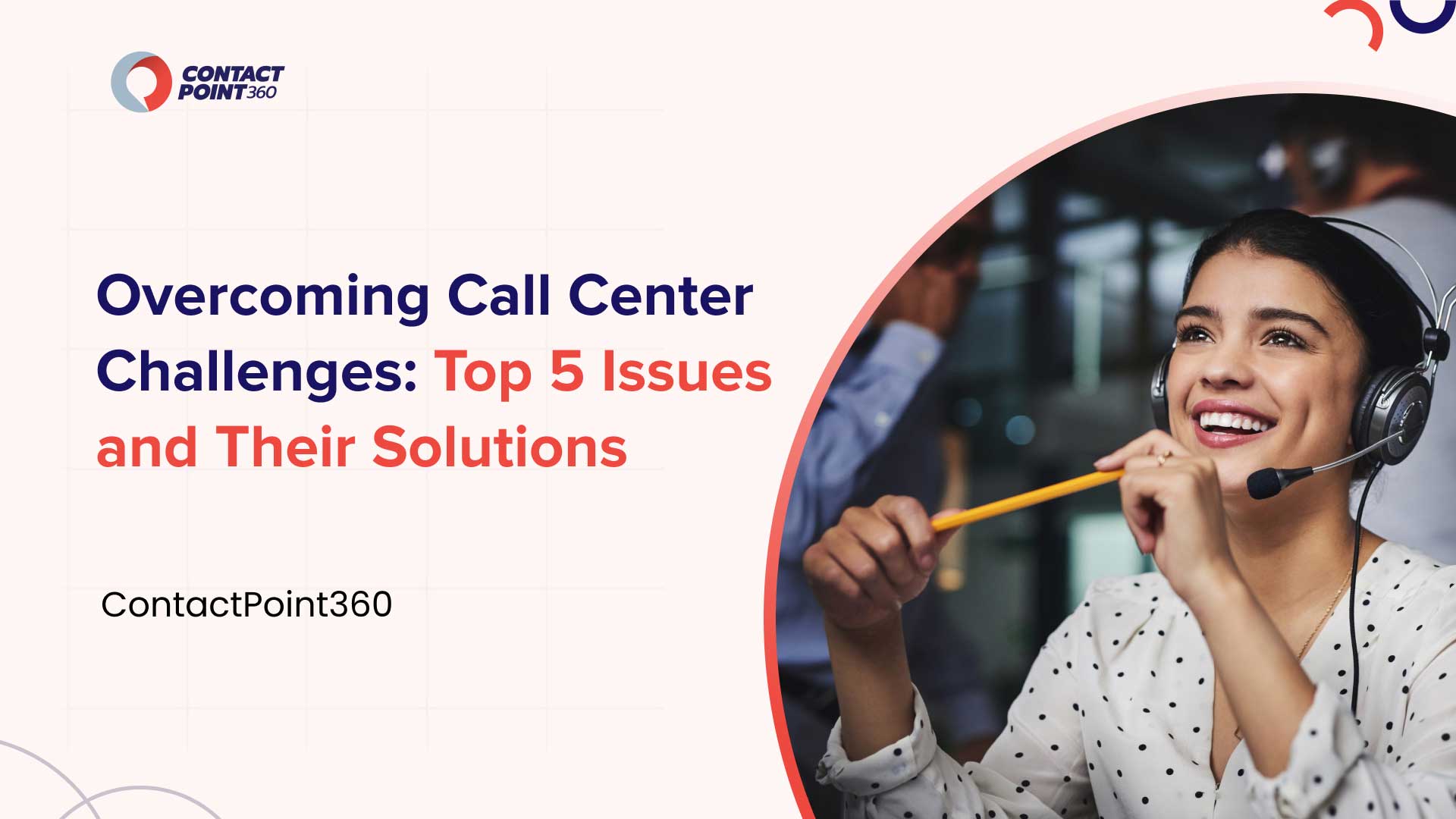As we all know, call centers are known for seamlessly resolving customer issues within minimal time. But, in the background, they run their operations 24/7 to cater to the needs of each stakeholder. Simultaneously, they face numerous call center challenges that impact their managers, agents, and customers.
This blog explores all those call center problems and their appropriate solutions, helping such centers to efficiently streamline workflow.
Top Call Center Problems and Solutions: A Complete Brief
As you know, call centers offer services to numerous industries and different sizes of organizations. Due to this, they face numerous challenges on daily basis. Some of the call center challenges are minor and get resolved quickly and at a personal end. However, there are some of the major and biggest challenges in call centers that need to be addressed at the earliest.
And among those, the top five contact center operational challenges are listed here with their appropriate solutions.
1. High Agent Turnover
The Challenge:
Agent turnover is one of the biggest challenges in call center industry. On a daily basis, an agent performs the same repetitive tasks in a high-stress environment. In addition, they have a limited work scope, which only revolves around a single set of customers and their repeated queries. Due to this, your agents lead to burnout, attrition, and frustration.
As a result, the agents resign from your call center and you have to undergo the following processes again:
- Hiring and training of new agents.
- Maintaining the disruptive operations with additional or third-party resources.
- Ensuring customers repeatedly that your service quality will improve.
Thus, high agent turnover creates supplementary call center problems.
The Solution:
To mitigate high agent turnover, you should focus on improving the work environment for your agents. Some of the most popular strategies for doing so includes:
Enhanced Training and Development: You should offer your agents frequent training and professional development courses, as it’ll help them feel more competent. Also, when your agents will implement the new learnings, productivity will increase.
Employee Engagement: You need to encourage a positive workplace culture through recognition programs, team-building activities, and open communications. It’ll result in better collaboration among agents, leading to reduce their workload.
Career Progression: You should establish clear career paths for all your call center executives. When you offer advancement opportunities, it motivates the agents to stay longer and improve their workflow to achieve designated posts and packages.
Work-Life Balance: With the implementation of flexible schedules and mental health support for agents, you can reduce burnout rate and improve retention. Also, you can help them enhance their efficiency by offering a reliable break hour and leaves.
2. Maintaining Consistent Service Quality
The Challenge:
The second biggest challenge in call centers specifically targets the quality of service. Whether it’s an in-house or outsourced call center, both need to maintain their quality to ensure customer satisfaction, conversion, and retention rates. But, with hundreds of calls to a single agent, inadequate monitoring, and lack of standardized processes creates a roadblock in achieving this target.
In addition, when you don’t focus on the challenges faced by call center agents, your service quality starts to lack. You need to ensure that all agents understand the customers, policies, and their workflow. Otherwise, every action will lead to inconsistency among customers.
The Solution:
To maintain consistent service quality, call centers should implement the following measures:
Standard Operating Procedures (SOPs): By developing SOPs , you will define all the support agent processes in accordance to quality, and customer metrics. So, whenever any agent will execute a process, you can assure quality of service.
Performance Metrics: While monitoring, you must focus on KPIs, such as abandonment rate, Average Handle Time (AHT), First Call Resolution (FCR), and Customer Satisfaction (CSAT) scores. Also, you should analyze the overall and individual agent’s productivity to make appropriate decisions.
Training and Coaching: Your call center should always have ongoing training programs for agents where they can enhance their skills. Moreover, your supervisors must offer personalized coaching sessions to help support executives stay aligned with quality expectations.
Quality Monitoring: You must regularly monitor calls and provide constructive feedback to agents. It can help you identify areas for improvement and ensure adherence to quality standards. In addition, it’s recommended to use an AI-based monitoring system to avail of data-driven insights.
3. Managing High Customer Volumes
The Challenge:
A call center handles customers through a number of channels, including calls, emails, and live chat. And with each passing day, the volume of customer queries and issues gets increases. Due to this, the three biggest challenges for call center managers:
- Making the agents work over time leads to burnout and customer dissatisfaction.
- Managing the available resources to cater to every customer.
- To lower the waiting time without quality compromise.
The Solution:
Effective strategies for managing high call volumes include:
Advanced Forecasting: Call center forecasting can be made easier by utilizing historical data and predictive analytics. Further, you can utilize all such information for effective resource planning and scheduling to ensure maximum availability.
Scalable Technology: With the configuration of cloud-based call center solutions. You can provide the flexibility to scale operations according to your requirements. Also, you can save costs by choosing the pay-per-use cloud engagement model.
Self-Service Options: There are numerous self-service channels, that you can offer to the customers. Some of the most popular mechanism includes, IVR (Interactive Voice Response), chatbots, and online FAQs. It’ll help you reduce the load on live agents and provide quick resolutions for common issues.
Efficient Routing: Intelligent call routing ensures that customers are getting forwarded to the most appropriate agent, which in turn reduces the wait times and enhances your first-call resolution rates.
Elevate Your Call Center Operations
with ContactPont360
4. Integrating Omnichannel Support
The Challenge:
Nowadays, there are a number of channels through which a company offers its services and products. And each customer prefers a different channel to interact with the brand. Because of this, call centers also have to build an omnichannel approach, so that every customer can reach out and their issue can get resolved.
But, integrating omnichannel communication solutions requires more resources and experts to manage the operations. In addition, sometimes, it becomes complex to address customers when they frequently change their means of contact. Moreover, embedding these multiple channels is still one of the top legacy call center challenges.
The Solution:
To effectively integrate omnichannel customer support, call centers should focus on:
Unified Communication Platforms: Implementing platforms that can connect all customer platforms into a centralized console will help you a lot. It will allow the agents to view the complete customer history and provide more informed support.
Consistent Branding: You should ensure that messaging and service quality are consistent across all channels. As a result, you’ll reinforce your brand reliability and customer trust. In addition, your brand voice will become a trademark, and people will easily focus on your products and services.
Agent Training: It’s one of the most important tasks while resolving the omnichannel issues. With the help of training, agents can efficiently handle interactions across all channels. They will easily understand the usage of all required tools and how to seamlessly switch between those communication platforms.
Data Analytics: You need a software solution to leverage call center data analytics. It’ll help you gain insights into customer preferences and behavior, leading to personalized interactions and improving customer satisfaction.
5. Adapting to Technological Advancements
The Challenge:
Technology is advancing at a rocket’s speed, which is kind of beneficial. But, it’s also creating some significant call center challenges. Firstly, the new technology is quite expensive, and you can only implement it if your current system fits within its compatibility requirements.
Further, if your IT infrastructure is considered outdated, then you need to spend more time updating the entire digital ecosystem. Moreover, you will require to train your call center agents according to the new software and hardware resources. And all this will also consume your additional cost, time, and effort.
The Solution:
You can consider the following strategies to mitigate the technology advancement issues:
Continuous Learning: You should provide continuous training to your agents, supervisors, and managers. The training should focus on hands-on experience with the new-age call center tools and solutions. It’ll help your human resources to easily adapt to new technology.
Gradual Integration: If you don’t have enough resources to implement every technology at once. Then, you can do it one by one. For instance, firstly, you can centralize your omnichannel approach; next, you can utilize automation and gradually move to AI-based solutions. This approach will save you time and cost.
Collaboration with IT: When you partner with an IT firm, your foundation become stronger. Also, if you have resources, you can even build an in-house IT team, which can help you build the required software and upgrade IT infrastructure at a gradual pace. In addition, the team can also help you achieve maximum availability.
Conclusion
Running contact center operations in a seamless way requires you to tackle numerous challenges. These challenges are for all the associated stakeholders, including the management, supervisors, and support agents. But, if you focus on each of the problems one at a time, you can quickly resolve them. Mostly, you should focus on the training of your agents, and IT systems, as they will lead to reduced workload, better productivity, and greater results.
Also, are you ready to elevate your call center operations? If so, then,
Discover how ContactPoint360 can help you overcome call center challenges and achieve exceptional customer service. You can connect with us now to explore tailored CX solutions for every industry and company at an affordable price.
However, if you currently have an in-house call center, then you should move to avail of contact center outsourcing services. Additionally, these services will aid you in saving time and support you increase ROI.
Overcome Call Center Challenges and Achieve Exceptional Customer Service
Frequently Asked Questions
What are the main causes of high agent turnover in call centers?
High agent turnover in call centers is primarily caused by job-related stress, repetitive tasks, lack of career advancement opportunities, and inadequate support or recognition from management. Addressing these issues through improved training, employee engagement programs, and clear career progression can help reduce turnover rates.
How can call centers improve service quality consistently?
To improve service quality consistently, call centers should implement standard operating procedures (SOPs), regularly monitor and evaluate calls, use key performance indicators (KPIs) to track performance, and provide ongoing training and coaching for agents.
What strategies can call centers use to manage high call volumes effectively?
Call centers can manage high call volumes by using advanced forecasting tools to predict call patterns, implementing scalable cloud-based solutions, offering self-service options like IVR and chatbots, and using intelligent call routing to ensure calls are handled by the most suitable agents.
What is the importance of omnichannel support in call centers?
Omnichannel support is crucial as it allows customers to interact with the call center through their preferred channels (phone, email, chat, social media) while receiving a consistent and seamless experience. Integrating these channels into a unified communication platform enhances customer satisfaction and loyalty.
How can call centers stay up-to-date with technological advancements?
Call centers can stay up-to-date with technological advancements by investing in continuous learning programs for their staff, gradually integrating new technologies to minimize disruption, collaborating closely with IT departments, and regularly seeking customer feedback to identify areas for technological improvements.























 United States
United States Canada
Canada Mexico
Mexico Colombia
Colombia Jamaica
Jamaica Philippines
Philippines India
India Egypt
Egypt




